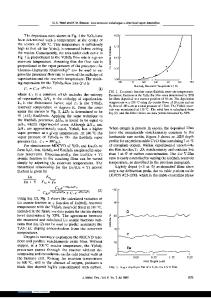Structural and Photoluminescent Studies of Eu 3+ -Doped Sr 2 SiO 4 Phosphor
- PDF / 2,273,791 Bytes
- 8 Pages / 595.276 x 790.866 pts Page_size
- 23 Downloads / 346 Views
ORIGINAL PAPER
Structural and Photoluminescent Studies of Eu3+-Doped Sr2SiO4 Phosphor M Somani1, M Saleem2*
, M Mittal1 and P K Sharma1
1
Department of Physics, Government Autonomous Holkar Science College, Indore 452001, India
2
Materials Science Laboratory, School of Physics, Vigyan Bhawan, Devi Ahilya University, Khandwa Road Campus, Indore 452001, India Received: 07 September 2018 / Accepted: 23 July 2019
Abstract: Here, we report the synthesis of Sr2-xEuxSiO4 (Sr2SiO4:Eu3?) [x = 0.01, 0.015, 0.02, 0.025, 0.03] silicate phosphors via high-temperature solid-state reaction method. The prepared phosphors were X-ray diffraction (XRD) characterized, and the analysis of XRD data conveyed that all the samples are crystalline, single-phased and have crystallized to orthorhombic structure (Pmnb). The structure, space group (Pmnb) and other structure concerned parameters were further verified using Rietveld refinement for x = 0.01 phosphor. The XRD pattern for all the synthesized phosphors was identical in appearance, and there is no evidence of the new peak with increased doping of Eu3? ion. This behavior may be attributed to the uniform distribution of rare earth Eu3? ion at Sr2? site due to comparative ionic size of the host and guest ion. The formation of Sr2SiO4:Eu3? phosphors is verified further by FTIR spectroscopic technique. To investigate optical band gap of prepared phosphors, UV–Vis diffuse reflectance spectroscopic studies have been carried out. Photoluminescence property of Sr2SiO4:Eu3? phosphors was studied. The emission spectrum displayed characteristic emission peaks corresponding to Eu3? around 587, 612 and 702 nm. The Commission International de I’Eclairage color coordinates were found lying in orange-red region. Keywords: XRD; Phosphor; Photoluminescence; CIE coordinates PACS Nos.: 81.20-n; 61.05.cp; 78.20-e; 78.30-j
1. Introduction Solid-state lighting by means of LEDs based on the Sr2SiO4 phosphors has attracted researchers because of their excellent performance such as high energy efficiency, and environmental protection. Light emitting diodes (LEDs) with their characteristics of high brightness, reliability, long life time, low environmental impact and energy efficiency are expected to replace conventional incandescent and fluorescent lamps in the near future. They exhibit easy, cost-effective and convenient manufacturing technology that guarantees their dominating nature in LED market. In addition to this, they are beneficial in terms of low production cost, possess high chemical and physical stability, have corrosion-resistant nature and are thermally stable [1, 2]. M2SiO4:Eu (M = Ca, Sr, Ba) phosphors have
attracted serious concentration of the phosphor community after the invention of white light emitting diodes (LEDs). The first Eu2?-activated luminescence in alkaline earth orthosilicate phosphor was reported in 1968. (Ca, Sr, Ba)2SiO4:Eu orthosilicate phosphors are excellent commercial phosphors for white LEDs as they exhibit high light conversion efficiency for near ultraviolet (NU
Data Loading...











